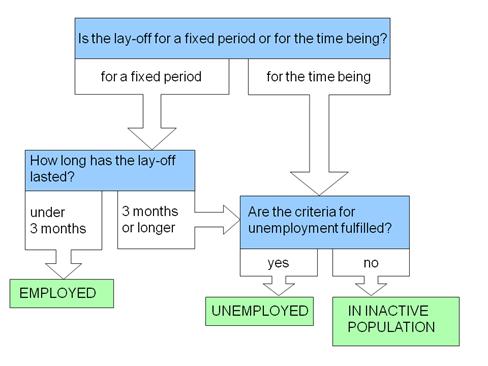Statistics on laid-off persons in Statistics Finland's Labour Force Survey and in the Employment Service Statistics of the Ministry of Employment and the Economy
Statistical data are available on the number of laid-off persons from both the Labour Force Survey of Statistics Finland and the Employment Service Statistics of the Ministry of Employment and the Economy. The data from the Labour Force Survey are based on the information given by the persons interviewed, while those from the Employment Service Statistics on the numbers of laid-off persons registered as job seekers at the employment and economic development offices.
It is difficult to describe the labour market position of laid-off persons by means of the conventional employed and unemployed concepts. This is a description of the definitions used in the statistics of Statistics Finland and of the Ministry of Employment and the Economy and the differences between them.
Laid-off persons in the Labour Force Survey
In Statistics Finland's Labour Force Survey, a person is defined as laid off if he or she has been completely absent from work in the survey week and in the interview reports temporary lay-off as the reason for the absence. The person can be laid off either for a fixed period or for the time being. Those having worked even a little during the survey week are not visible as being laid off in the Labour Force Survey. The number of laid-off persons thus does not include those laid off part-time or those whose laid-off period has started in the middle of the survey week.
In the Labour Force Survey, a laid-off person can be defined either as an employed person, unemployed person or as being in the inactive population. In the Labour Force Survey, a laid-off person is defined as employed if the temporary lay-off is for a fixed period and has lasted not longer than three months. Among persons laid off for the time being, as unemployed are classified those who meet the criteria for unemployment, that is, have looked for a new job and would be available for work. A person laid off for a fixed period can also be classified as unemployed if the absence from work has lasted for over three months and the criteria for unemployment are fulfilled. If the criteria for unemployment are not fulfilled, they are classified as being in the inactive population. For example, in the first two quarters of 2013, nearly one-third of laid-off persons were classified as employed, good one-fifth as unemployed and nearly one-half in the inactive population. (Figure 1.)
Figure 1. Definition of the labour market position of a laid-off person in the Labour Force Survey

Laid-off persons in the Employment Service Statistics
In the Employment Service Statistics of the Ministry of Employment and the Economy, persons laid-off fully are included in the number of unemployed job seekers on the basis of legislation. The Ministry of Employment and the Economy publishes information on the number of laid-off persons monthly in its Employment Bulletin.
Lay-offs can be implemented fully or as a reduced working week. Of them, persons laid off fully are counted in unemployed job seekers. Persons working a reduced working week are also followed in the Employment Service Statistics.
The laid-off procedure was changed on 1 July 2013. Until then, lay-offs were divided into those individually laid off and those laid off as a group. Individually laid-off persons had to register as job seekers to receive unemployment benefit for the laid-off period. In practice, all individually laid-off persons were included in laid-off persons in the Employment Service Statistics. In contrast, in group lay-offs, where an employer laid off at least ten persons at a time for a fixed period, the compensation practice was different and registration was not mandatory. Therefore, most of those covered by group lay-offs were not visible in the Employment Service Statistics as either laid off or unemployed. However, the Ministry of Employment and the Economy followed the numbers of group lay-offs and reported on them separately. Along with the change in the lay-off procedure, the division into individually laid-off and group lay-offs was discontinued. After the change, all laid-off persons must register as job seekers at the employment and economic development offices. Thus, all laid-off persons can also be seen in the figures of the Employment Service Statistics. Depending on the month, it is estimated that the visibility of lay-offs corresponding to previous group lay-offs in the Employment Service Statistics raises the numbers of persons fully laid off and unemployed job seekers by 4,000 to 10,000 persons per month.
Last updated 25.9.2013
Official Statistics of Finland (OSF):
Labour force survey [e-publication].
ISSN=1798-7857. Helsinki: Statistics Finland [referred: 28.12.2025].
Access method: http://stat.fi/til/tyti/tyti_2013-08-20_men_006_en.html

